Beef Olives have a reputation for being somewhat “old school”, but that certainly doesn’t mean they’re off-limits for us. We love a little nostalgia, and a Beef Olive recipe certainly gives us that!
While Phil had never heard of them, they regularly featured on the menu for Sonja when she was growing up. But it’s been a LONG time since she even thought about them.
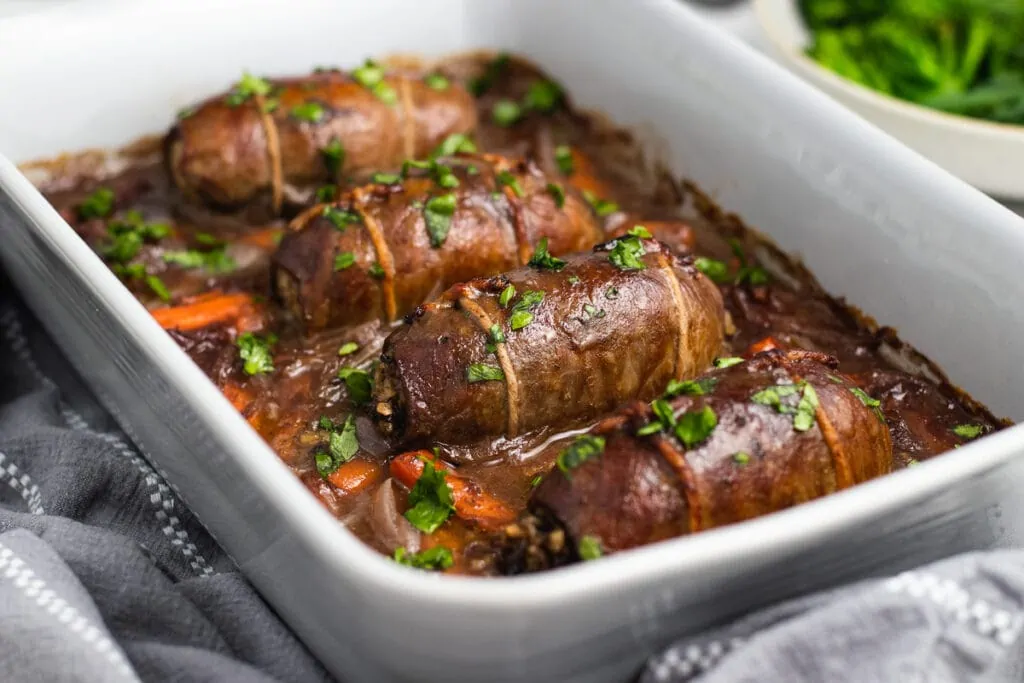
That is, until we saw Beef Olives on a menu in the Scottish Highlands, and we’ve spotted them in a few supermarkets and restaurants since!
Although something else took our fancy on the menu that night, a discussion ensued about what exactly constituted a Beef Olive and why it might be called that.
After all, how can you have a beef… olive!
The mind boggles at this strangely named food, so here is our explanation and our Beef Olive recipe, complete with variations for the inside of the “olive”.
Pin for later!
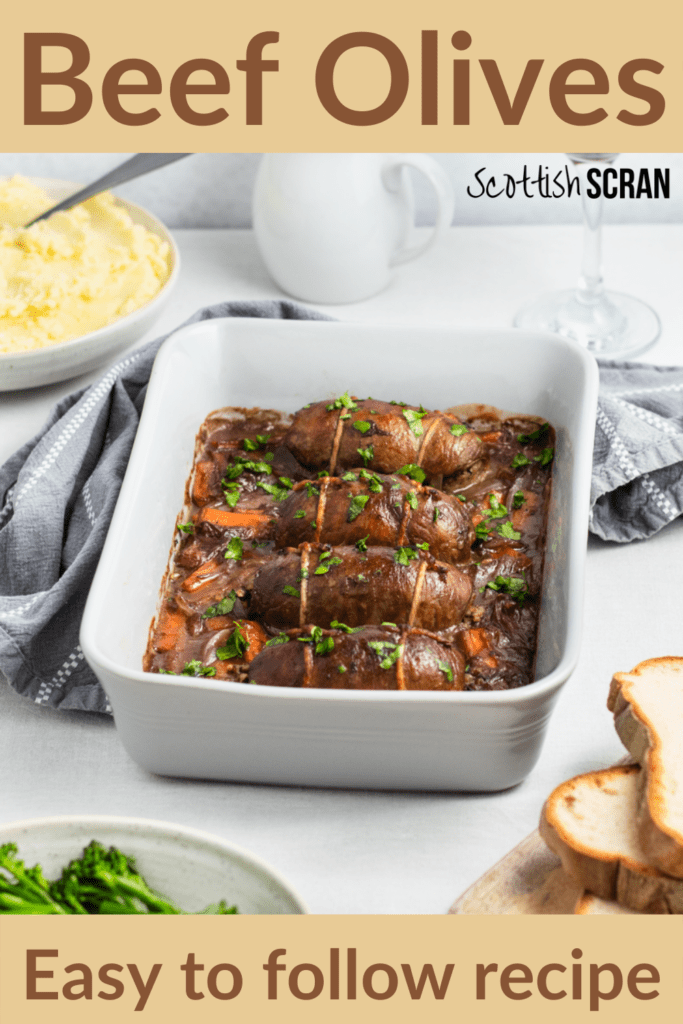
A lesser-known dish than perhaps Balmoral Chicken or Haggis, Beef Olives are often claimed as a Scottish dish, though the rest of Britain may have something to say about that. We go into a bit more detail about their origin below.
Like some other Scottish foods, they have a name that doesn’t sound like it has anything to do with what you’ll be served. We’re looking at you, Black Pudding, Rock Cakes and Tipsy Laird!
However, these are now back in rotation at our house, alongside classic desserts like Cornflake Tart. And we’re not complaining!
What are Beef Olives?
To put it simply, Beef Olives are thin beef steaks wrapped around sausage meat, skirlie, stuffing or even haggis.
Spoiler Alert: Beef Olives have no olives in them. I mean, you could add them if you want to…
These are browned and then cooked in a casserole dish until they are tender and delicious. We chose to cook ours in a good red wine beef stock to bring out the tastes of both the tender beef and your filling of choice.
When served with potatoes and veg, it’s hard to beat our Beef Olives recipe as a truly tasty dish that will fill up the whole family.
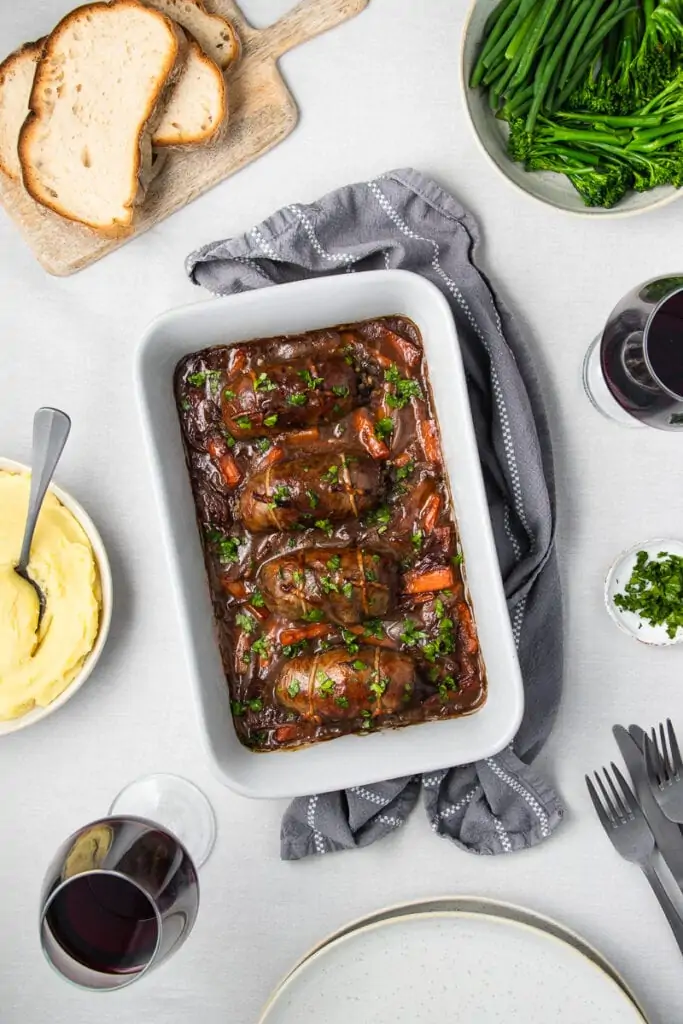
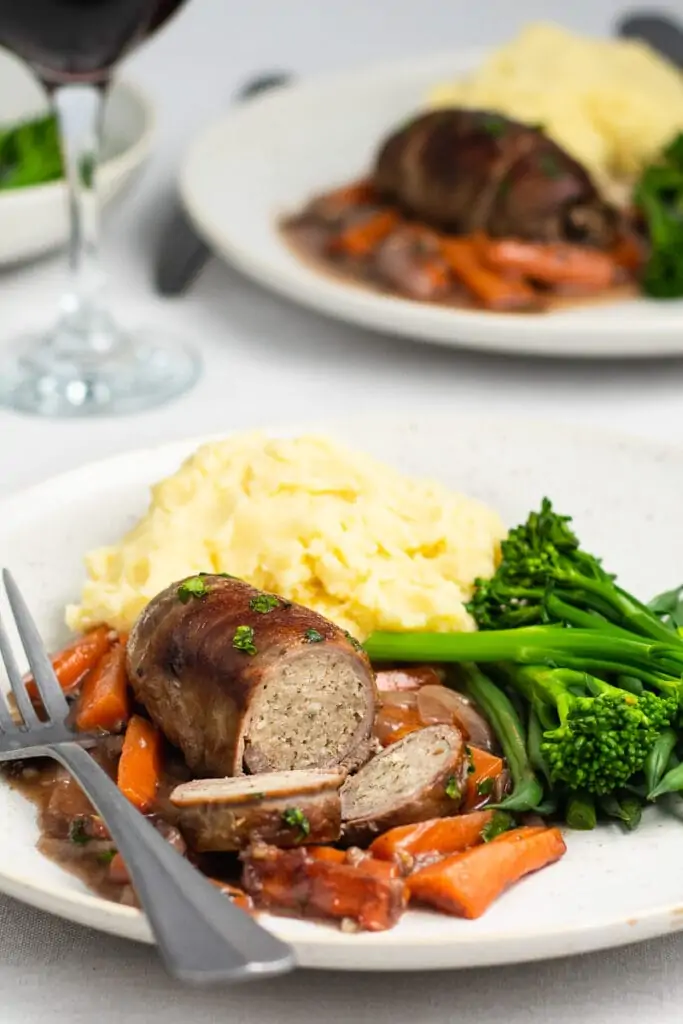
When were Beef Olives first made?
We originally thought that Beef Olives might be something from the 70s or 80s, but they’re much older than that.
It’s hard to believe, but people in Scotland have been making a version of a Beef Olives recipe since the middle ages!
First mentioned in a cookbook in the 16th Century, this simple dish would have been made from tenderised veal or mutton, likely wrapped around an oat-based stuffing.
Why are Beef Olives called Beef Olives?
The question, “why are beef olives called Beef Olives” doesn’t seem to have a definitive answer. With many of our recipes heralding from so far back in time, the original reason for their name can become a little lost.
Some say they’re called ‘olives’ because they look like a stuffed olive. Olives first appeared in Britain in 150BC, so this could easily be true.
Another explanation is that the name is a mistake. They were said to be known as Alloes or Alou of Beef; Alouette is an Old French word for Lark. They were named this because the small beef parcels looked like small birds or larks.
Olive is a simple mispronunciation of Alloes that has stuck. Alloes with beef date from the late 15th Century and were described as beef rolls stuffed with herbs and onions.
We think they do look a little like a stuffed olive, but we love the idea that their name is a simple mistake!
At the end of the day, no one really knows why they’re called Beef Olives, so let’s get on with the recipe…
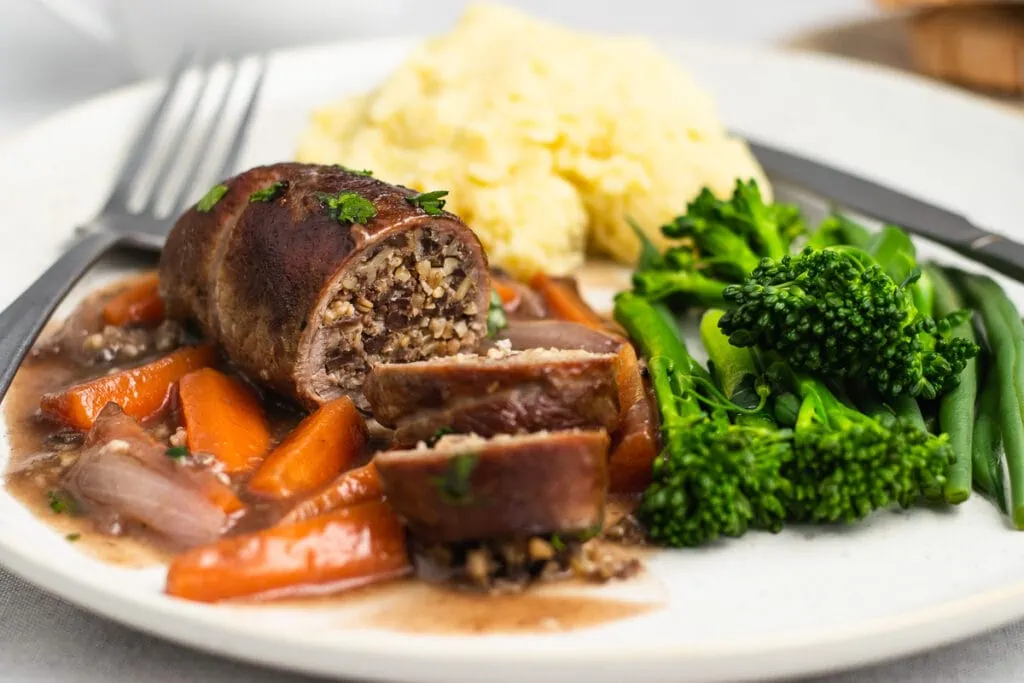
Things you’ll need to make Beef Olives
- Food processor
- Chopping board
- Food safe twine
- Large frying pan
- Large casserole dish
Ingredients for Beef Olives
We love to mix it up a little when making Beef Olives, so our recipe includes two olives stuffed with sausage meat and two stuffed with haggis.
If you prefer one or the other, simply adapt the recipe accordingly. Double the stuffing of choice and remove the stuffing that is no longer required.
You could also opt for other things like Skirlie or a mixture of sausage and haggis. It’s all up to you! That’s the nice thing about Beef Olives, everyone has their favourite kind!
Sonja grew up with Beef Olives containing a soft stuffing mixture like you’d put inside a roast chicken!
The Beef
- 4 thin-cut beef steaks
the STUFFING:
Sausage Stuffing
- 100g sausage meat (1/3 cup + 2 tbsp)
- 20g breadcrumbs (3 tbsp)
- 2 tsp fresh chopped sage
- ½ onion (roughly chopped)
- 1 large clove of garlic (roughly chopped)
- Salt and pepper to taste
Haggis Stuffing
- 180g haggis (3/4 cup)
the sAUCE:
- 1 onion (chopped)
- 2 large carrots (peeled and chopped)
- 300ml beef stock (1 ¼ cups)
- 100ml red wine (1/3 cup + 2 tbsp)
- 1 tbsp plain flour
- Salt and pepper to taste
This sauce is optional, as you could just cook the olives in the oven on their own, but we think they taste much better when cooked in a sauce.
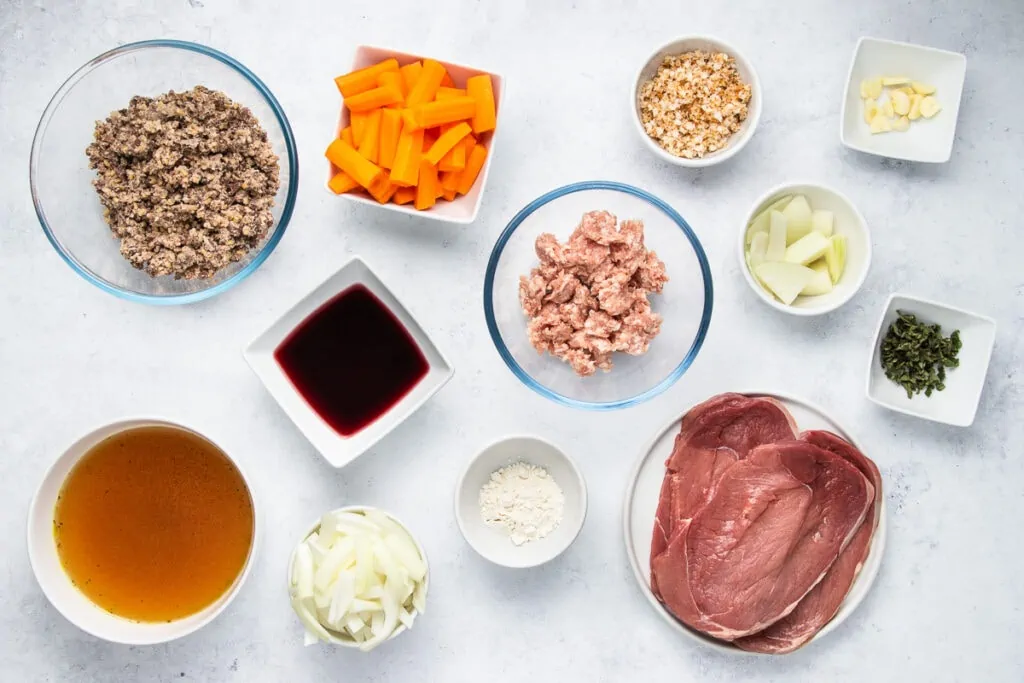
How to make Beef Olives – Step-by-step method
Yield: 4 Beef Olives
Prep time: 20 minutes
Chilling time: 1 hour 15 minutes
Layout your 4 steaks and season them with a pinch of salt and pepper to taste.
For Sausage Filling – Add the sausage meat, breadcrumbs, sage, ½ onion, garlic and some salt and pepper to taste to the bowl of a food processor. Blitz until thoroughly combined.
Split the sausage meat into two equal parts and roll them into a sausage shape about the width of your steaks. Place the two sausages about an inch from the end of two of the steaks.
For Haggis Filling – Split the haggis into two equal parts and again roll these into sausages. Place these on the other two steaks.
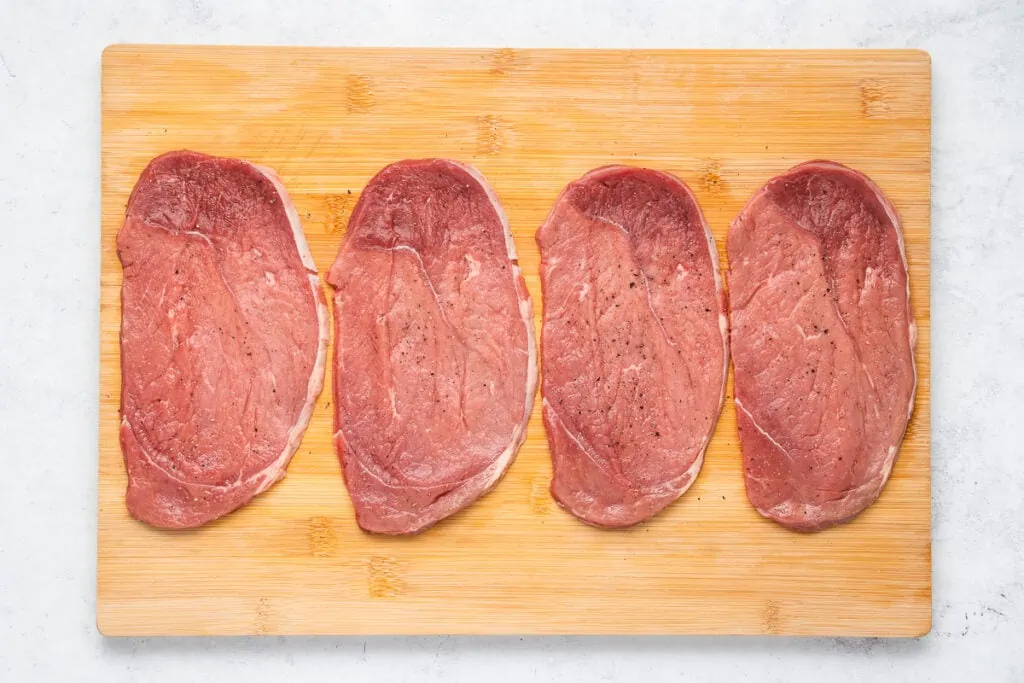
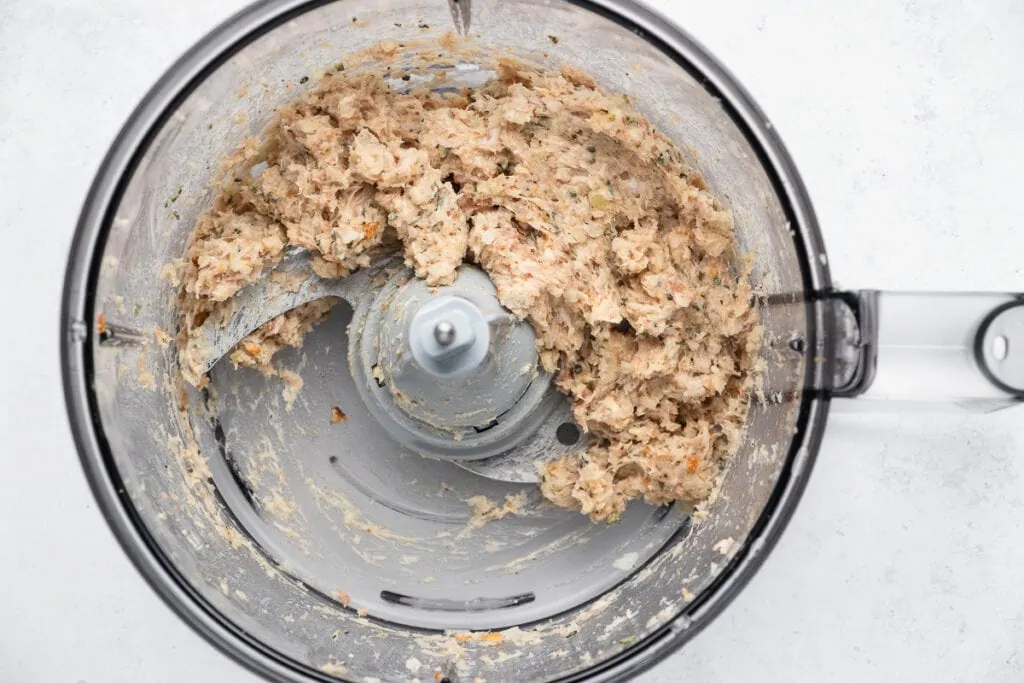
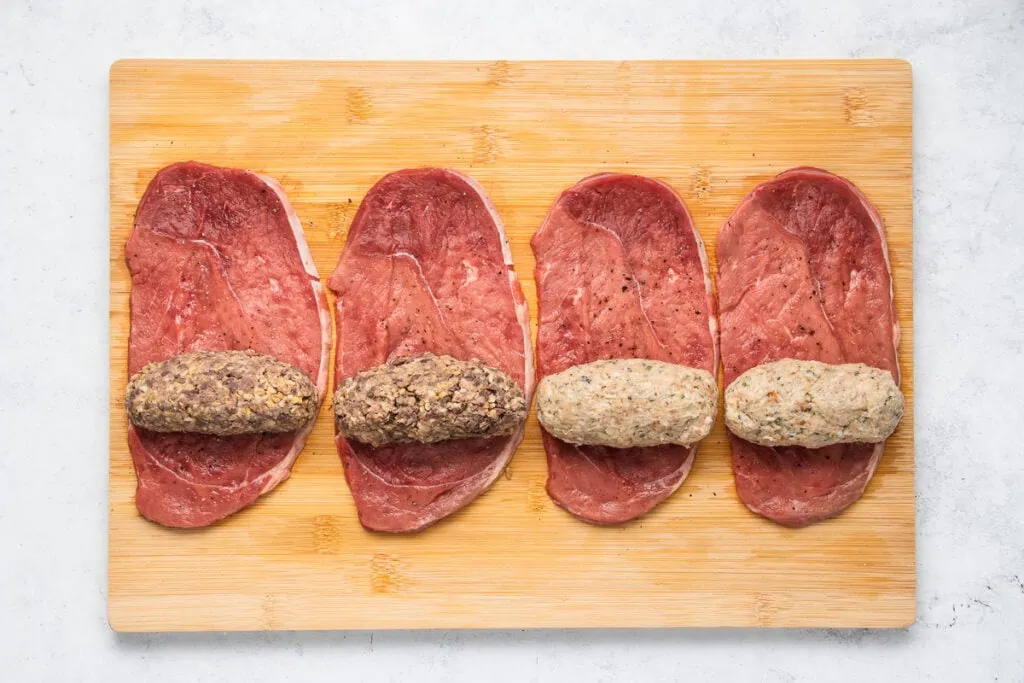
Starting from the short edge with the sausages/haggis on, carefully roll up each steak, completely enclosing the filling. Then tie each steak parcel securely using food-safe twine.
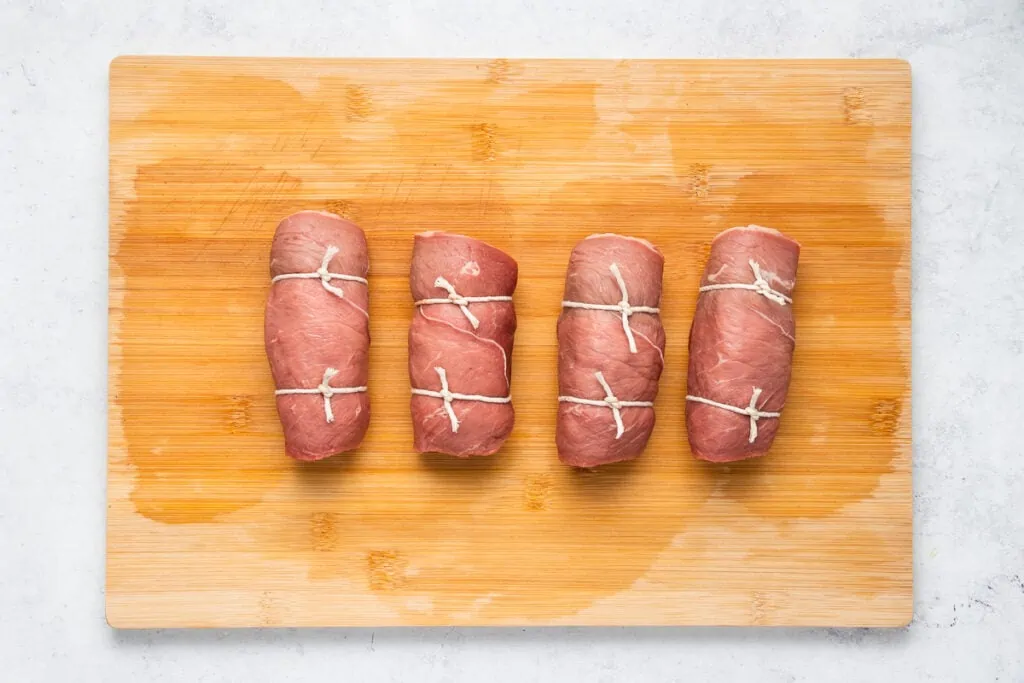
Heat a little oil in a frying pan on a medium heat. Brown the beef olives, frying for approx.
2 minutes on each side, depending on thickness. Then remove them from the pan and set them aside.
Add another splash of oil to the pan. Add the onion and carrots and fry until softened – about 5 minutes.
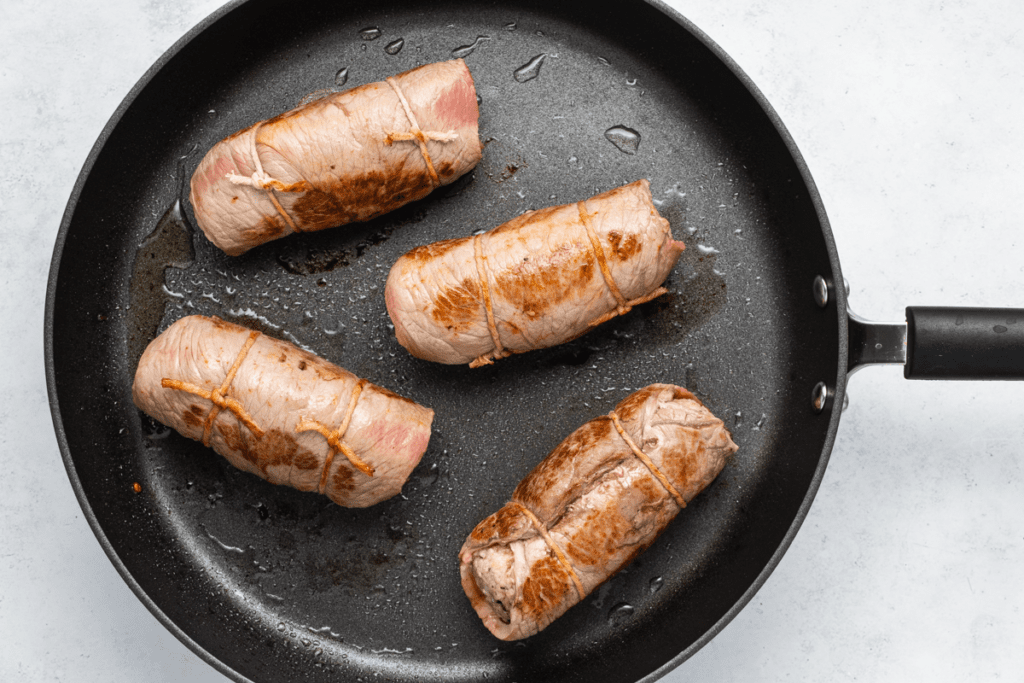
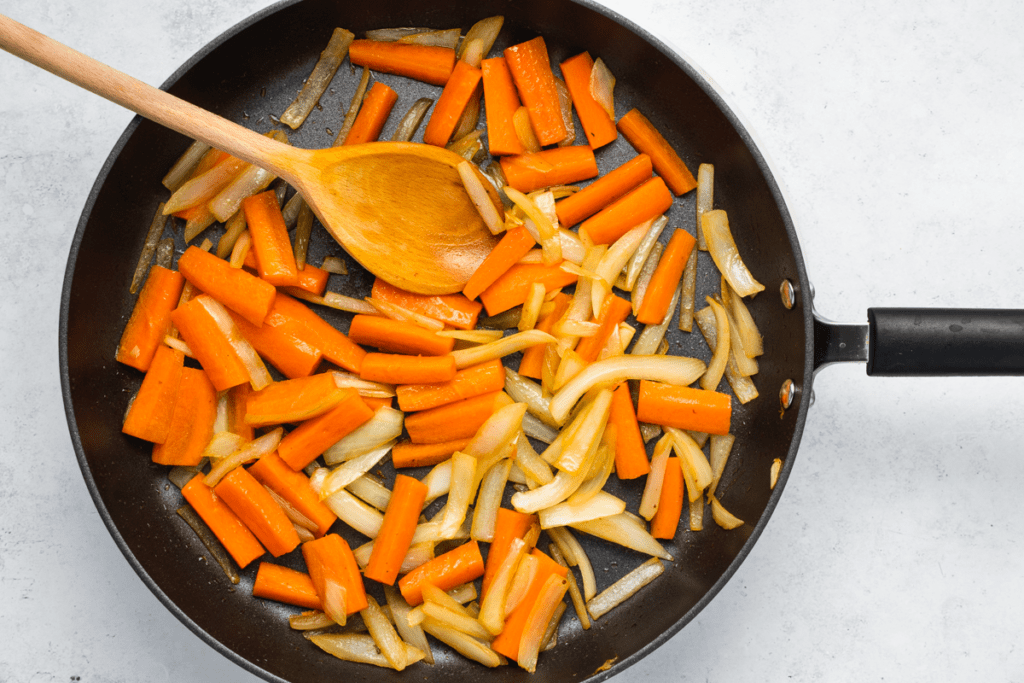
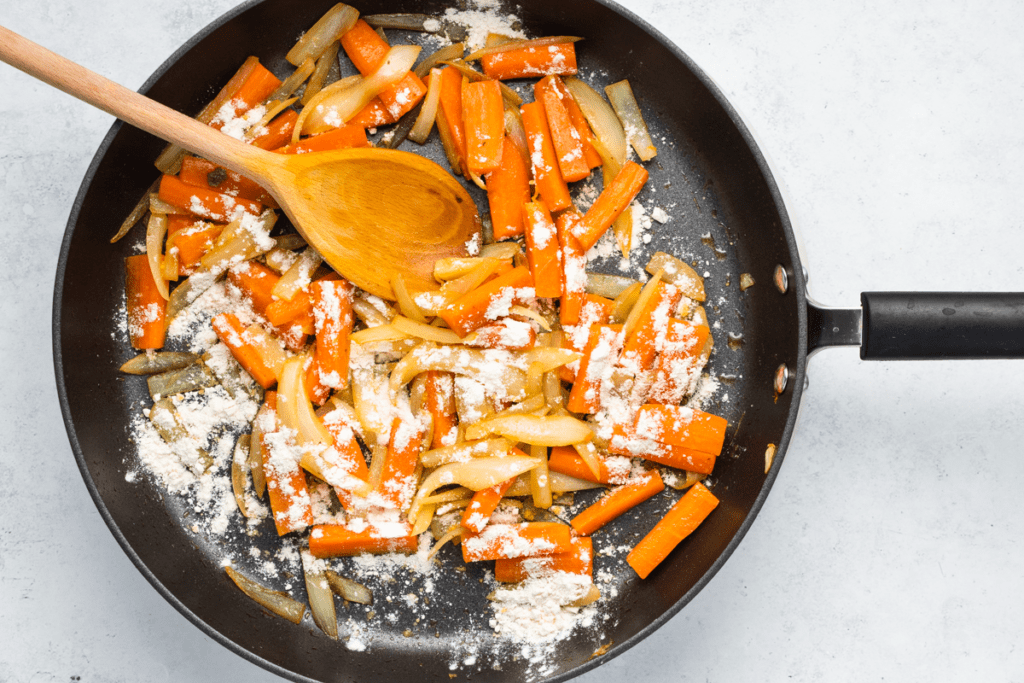
Sprinkle over the flour and stir well to combine.
Gradually add the wine, stirring as you go. Then slowly pour in the beef stock, again stirring after each addition.
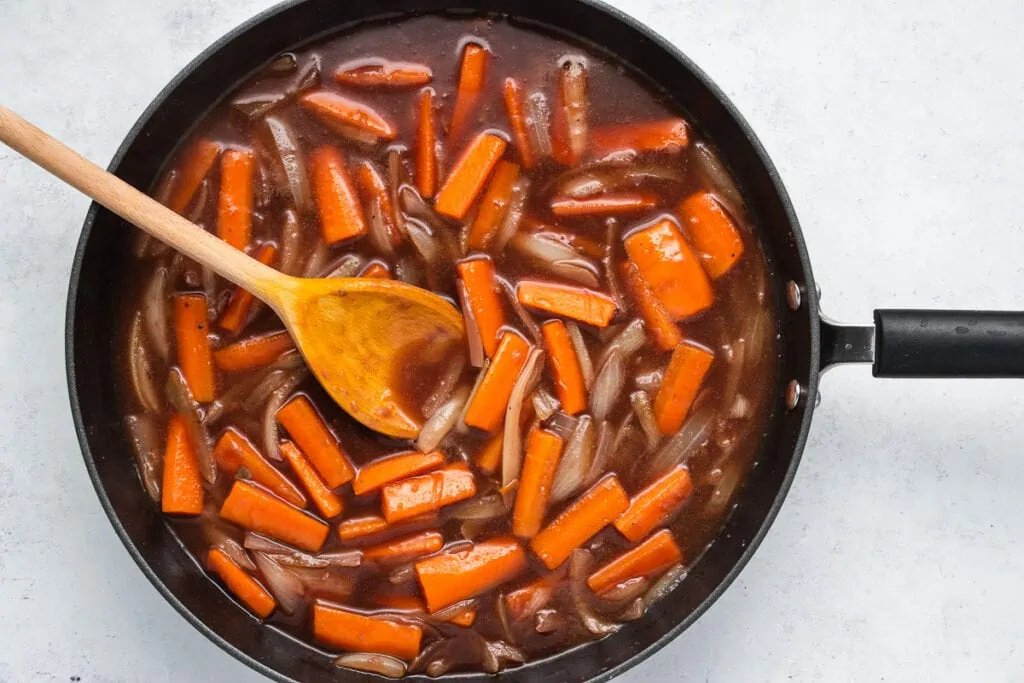
Add some seasoning to taste, bring to the boil, and then reduce to a simmer.
Let the sauce cook for another 5 minutes. While it simmers, preheat the oven to 170C.
Transfer the sauce to a baking dish, then place the beef olives on top.
Bake in the oven for 1 hour.
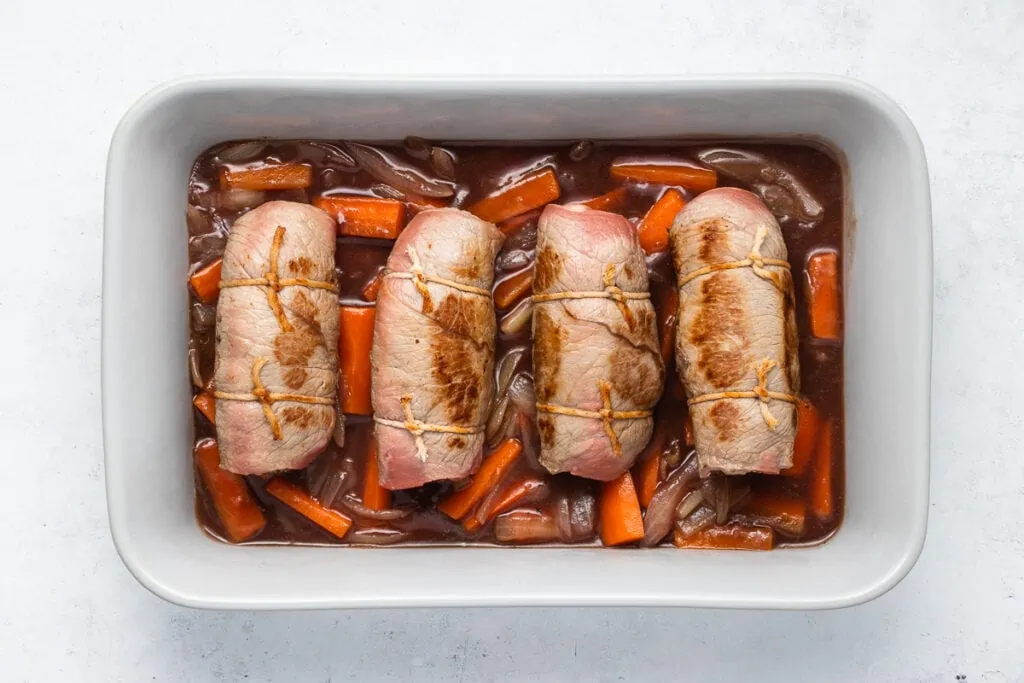
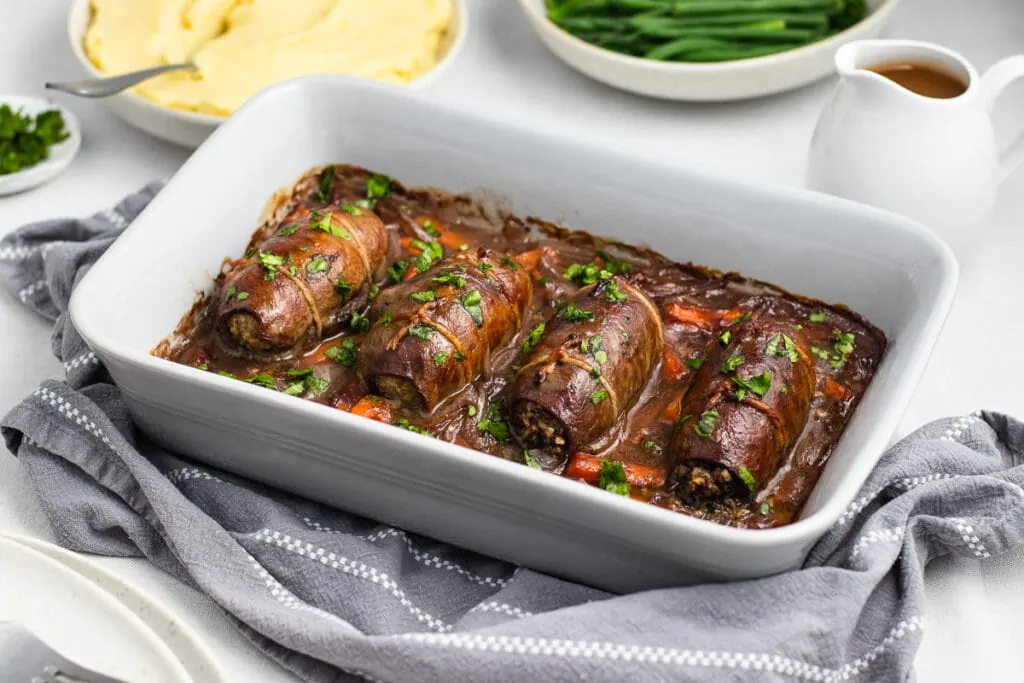
Variations
Our Beef Olive Recipe uses sausage meat and haggis to provide a delicious stuffing, but there are numerous variations to try until you find the one that’s exactly right for you.
For example, you could mix the sausage meat and haggis together to capture the best of both worlds.
You could use Skirlie or sage and onion stuffing to give the dish a little more texture and a little less meat.
You could add small pieces of smoked bacon or chopped chorizo to pork mince to add a burst of flavour.
New Zealand supermarkets tend to have Beef Olives with roast dinner stuffing inside, which is what Sonja grew up with.
There really is no limit to the variations, but we like to keep things traditional here at Scottish Scran.
After all, if your beef olive ain’t broken, why stuff it with something else… or something like that!?
Let us know if you make a different variation!
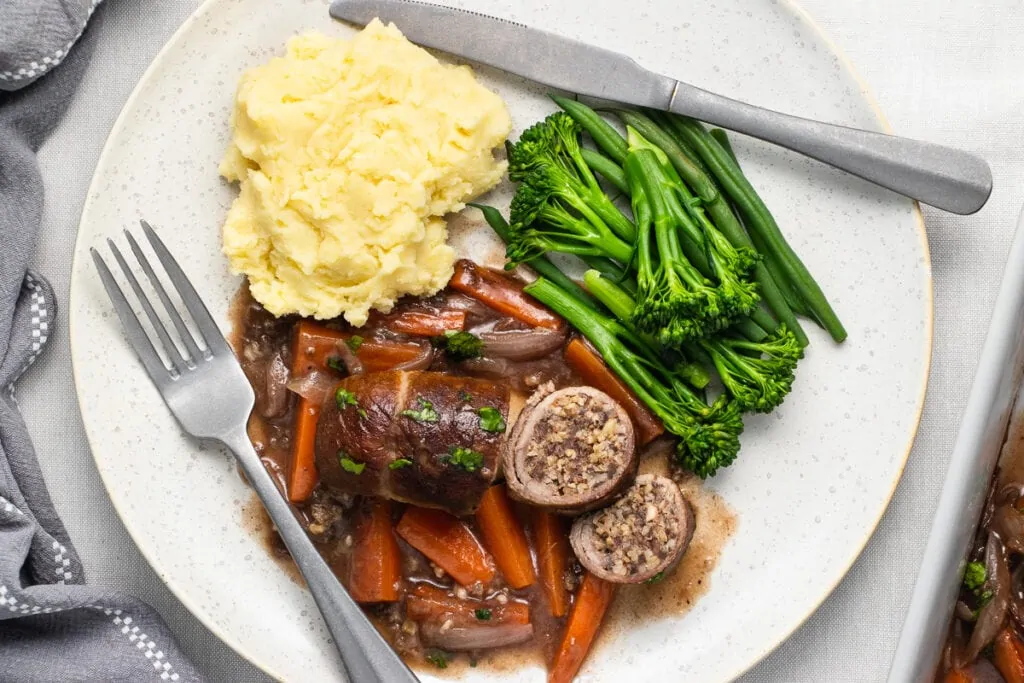
Can you reheat Beef Olives?
We would suggest eating your beef olives once they’re cooked, reheating can dry out the beef, and the various stuffings can mean it’s tricky to heat thoroughly.
If reheating is necessary, we suggest using a meat thermometer to ensure your olive is heated through and through.
You can either reheat it in the microwave (although the meat may become a little tough) or slowly in the oven.
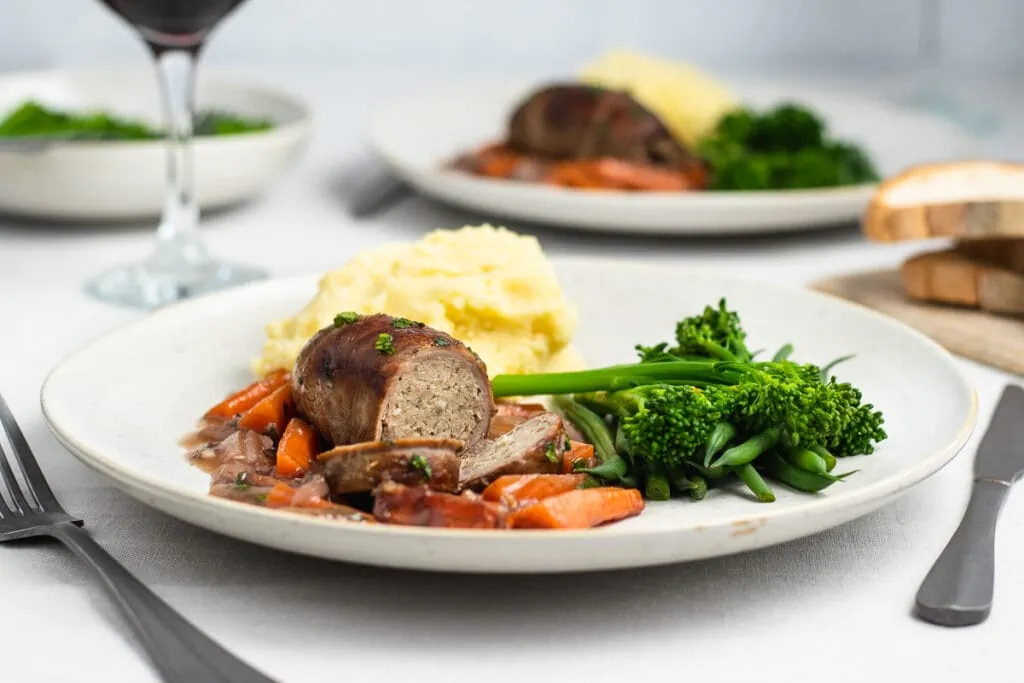
Do you have to make the sauce?
You can cook your beef olives in a few different ways.
We like to cook ours in a sauce in the oven as we find it stops them from drying out too much.
However, you can cook them without the sauce, just keep an eye on them and turn them a couple of times so they don’t go dry.
Alternatively, you could cook them on a very low heat in a pan on the stovetop, with a lid covering them to keep in heat and moisture.
Simple Beef Olives Recipe
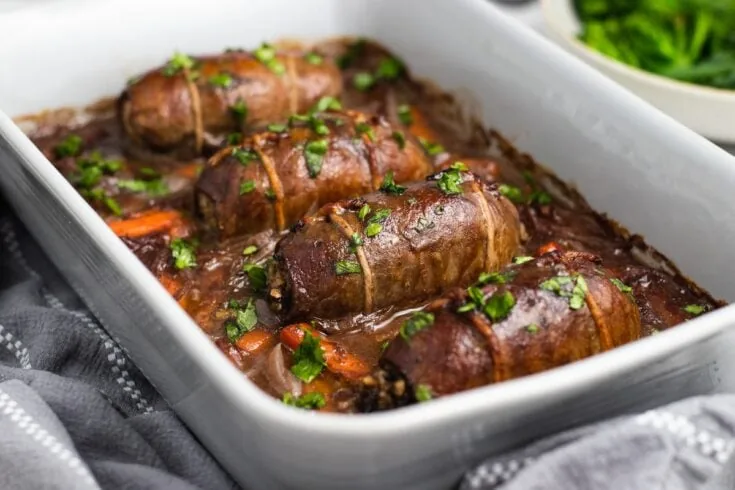
Beef Olives are a traditionally British recipe that has been around since the middle ages! No one knows quite why they're called "beef olives", but it's basically a thin piece of beef wrapped around a filling like sausage meat or stuffing, or in our case, haggis or skirlie!
This recipe makes two sausage stuffed and two haggis stuffed beef olives. You can easily omit the haggis and double the sausage ingredients, or change them all to a.stuffing or skirlie filling instead. It's up to you!
Ingredients
- 4 thin cut beef steaks
For the stuffing
- 100g sausage meat (1/3 cup + 2 tbsp)
- 20g breadcrumbs (3 tbsp)
- 2 tsp fresh chopped sage
- ½ onion (roughly chopped)
- 1 large clove garlic (roughly chopped)
- Salt and pepper to taste
- 180g haggis (3/4 cup)
For the sauce
- 1 onion (chopped)
- 2 large carrots (peeled and chopped)
- 300ml beef stock (1 ¼ cups)
- 100ml red wine (1/3 cup + 2 tbsp)
- 1 tbsp plain flour
- Salt and pepper to taste
Instructions
- Lay out your 4 steaks and season them with a little salt and pepper.
- Add the sausage meat, breadcrumbs, sage, ½ onion, garlic and some salt and pepper to taste to the bowl of a food processor. Blitz until completely combined.
- Split the sausage meat into two equal parts and roll them into a sausage shapes about the width of your steaks. Place the two sausages about an inch from the end of two of the steaks.
- Split the haggis into two equal parts and again roll these into sausages. Place these on the other two steaks.
- Starting from the short edge with the sausages on, carefully roll up each steaks so the filling is completely enclosed. Then tie each steak parcel securely using food safe twine.
- Heat a little oil in a frying pan on a medium heat. Brown the beef olives, frying for approx. 2 minutes on each side. Then remove them from the pan and set aside.
- Add another splash of oil to the pan. Add the onion and carrots and fry until softened – about 5 minutes.
- Sprinkle over the flour and stir well to combine.
- Gradually add the wine, stirring as you go. Then gradually pour in the beef stock, again stirring after each addition.
- Add some seasoning to taste, bring to the boil then reduce to a simmer.
- Let the sauce cook for another 5 minutes. While it simmers, preheat the oven to 170C.
- Transfer the sauce to a baking dish, then place the beef olives on top.
- Bake in the oven for 1 hour.
Notes
Note that we have made two haggis and two sausage meet beef olives. Feel free to make all sausage meat, all haggis, or change to stuffing or skirlie. It's totally up to you!
If you'd rather not cook with wine you can just add more stock.
Nutrition Information:
Yield:
6Serving Size:
1Amount Per Serving: Calories: 644Total Fat: 41gSaturated Fat: 17gTrans Fat: 0gUnsaturated Fat: 19gCholesterol: 228mgSodium: 519mgCarbohydrates: 10gFiber: 1gSugar: 3gProtein: 52g
These values are an estimate only
Other Popular Scottish Savoury Dishes To Try
- Mince and Tatties
- 32 Recipe ideas for Haggis
- Homemade Lorne Sausage
- Traditional Clapshot Recipe
- Balmoral Chicken
- Traditional Scottish Skirlie Recipe
- Traditional Rumbledethumps Recipe
We hope you enjoy tucking into this classic dinner dish! Let us know how you decide to make it.
Phil and Sonja x

I am 70 years-old and Scottish, although I haven’t lived there since I was 18.
When I was a kid, beef olives were a favourite dinner. I’m sure my mother bought them pre-formed from the local butcher and then cooked them. They were always stuffed with sausage meat – never haggis. Haggis was always served proudly and reverentially as haggis. Never any other way.
As to the name, although as you say the first mention is from the late 16th century, it wasn’t from a Scottish source. In fact, all the early examples found were English. As a retired professor of Linguistics I don’t for a minute believe the mispronunciate theory.
Anyway, thanks. Loving your site.
As an Englishman (of similar maturity) living in Scotland, I enjoy the traditional presentation of Haggis, we are lucky to have a local butchers (including Puddledub) who provide high quality meat products.
Over the years I have successfully introduced several friends and visitors to the delights of Haggis, by stealthily using it as the filling in Ravioli with tomato sauce, as well I pies and bridies.
Vegetarian Haggis works well as well.
For fun make both and let your guests participate in Vegan Roulettes.
Temperature of the oven would be helpful.
Hi Maureen, the temp is in the post and on the recipe card 170 degrees C. Hope this helps.
Could these be made in the slow cooker, I have a 3.5 litre.
We honestly don’t know as we don’t use a slow cooker. As we understand it, sauces don’t thicken up that well, so you may need to add some corn flour etc, towards the end of the cook and of course make sure they’re piping hot.
What sausage do you use? Is it findable in the US? I like your site, haven’t tried anything yet, that will have to be on next weeks menu. Already made out and shopped for this week.
We just used standard pork sausage meat, it has a little more fat, so it means it doesn’t dry out.
I used plain ground pork
We are currently having our kitchen re fitted and I wanted a proper dinner even though I only have a ninja and microwave to use. I managed to do the olives all in the single pot taking things in and out and changing settings. Thank you for an amazing recipe that has given me a real dinner amongst the chaos!
That’s great! We’ll have to try that ourselves.
Not a Scottish recipe – it’s actually English
We didn’t claim they were Pete, but they have been made in Scotland since the mid 16th century. How long do you have to be here to call it home?
Haven’t had these in forever, and the memory was not good of chewy beef round a fat stewed sausage link. Think 1960’s Scotland!
Anyway, I made them for my English (he can’t help that) hubby tonight, he loved them, and has asked for them to be a regular fall/winter dinner. Yay!
I only did the sausage filling as we’re fresh out of haggis in Philadelphia!
As a fellow Englishman your hubby obviously has excellent taste! – Phil
my gran used to make these – 2nd favorite after Mince & Tatties!
Actually an old English recipe but great to see people making them – don’t see them around much anyone. This recipe is great, tried it out and was very happy with the results!
If you’re ever in London “Rules Restaurant” (actually London’s oldest restaurant) make this and it’s fab. They do lots of old school recipes that aren’t frequently made these days, all of them fab!! Worth popping in if you’re ever in town!
I cooked as per instructions and the sauce completely dried out and stuck to the bottom of the pan?
We’re not sure why this might be as we have tested this recipe on our children and ourselves at tea times many times. Ovens do cook at different temperatures though so this migh tbe the case here.